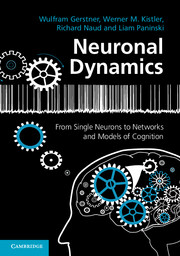Book contents
- Frontmatter
- Contents
- Preface
- PART ONE FOUNDATIONS OF NEURONAL DYNAMICS
- PART TWO GENERALIZED INTEGRATE-AND-FIRE NEURONS
- 5 Nonlinear integrate-and-fire models
- 6 Adaptation and firing patterns
- 7 Variability of spike trains and neural codes
- 8 Noisy input models: barrage of spike arrivals
- 9 Noisy output: escape rate and soft threshold
- 10 Estimating parameters of probabilistic neuron models
- 11 Encoding and decoding with stochastic neuron models
- PART THREE NETWORKS OF NEURONS AND POPULATION ACTIVITY
- PART FOUR DYNAMICS OF COGNITION
- References
- Index
9 - Noisy output: escape rate and soft threshold
Published online by Cambridge University Press: 05 August 2014
- Frontmatter
- Contents
- Preface
- PART ONE FOUNDATIONS OF NEURONAL DYNAMICS
- PART TWO GENERALIZED INTEGRATE-AND-FIRE NEURONS
- 5 Nonlinear integrate-and-fire models
- 6 Adaptation and firing patterns
- 7 Variability of spike trains and neural codes
- 8 Noisy input models: barrage of spike arrivals
- 9 Noisy output: escape rate and soft threshold
- 10 Estimating parameters of probabilistic neuron models
- 11 Encoding and decoding with stochastic neuron models
- PART THREE NETWORKS OF NEURONS AND POPULATION ACTIVITY
- PART FOUR DYNAMICS OF COGNITION
- References
- Index
Summary
There are various ways to introduce noise in formal spiking neuron models. In the previous chapter we focused on input noise in the form of stochastic spike arrival. In this chapter we assume that the input is known or can be estimated. Stochasticity arises at the level of the neuronal spike generation, i.e., at the moment of the output. The noisy output can be interpreted as arising from a “soft” threshold that enables an “escape” of the membrane potential across the threshold even before the threshold is reached. Models with a noisy threshold or escape noise are the basis of Generalized Linear Models which will be used in Chapters 10 and 11 as a powerful statistical tool for modeling spike-train data.
In Section 9.1, the notion of escape noise is introduced. In Section 9.2 we determine the likelihood that a specific spike train is generated by a neuron model with escape noise. In Section 9.3 we apply the escape noise formalism to the Spike Response Model already encountered in Chapter 6 and show an interesting link to the renewal statistics encountered in Chapter 7. The escape rate formalism gives rise to an efficient description of noise processes, independently of their biophysical nature, be it channel noise or stochastic spike arrival. Indeed, as shown in Section 9.4, noisy input models and noisy output models can behave rather similarly.
Information
- Type
- Chapter
- Information
- Neuronal DynamicsFrom Single Neurons to Networks and Models of Cognition, pp. 224 - 242Publisher: Cambridge University PressPrint publication year: 2014
